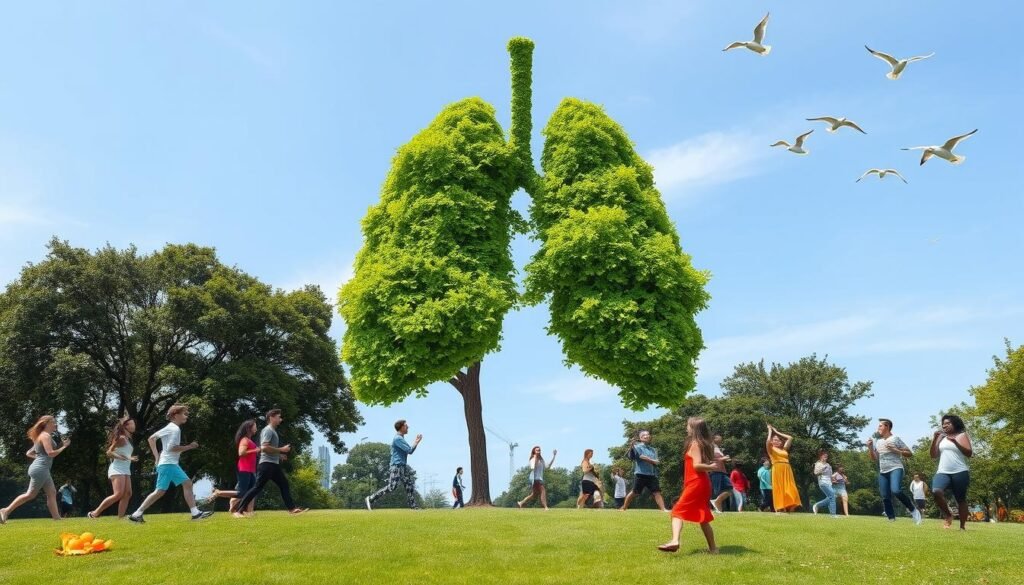Did you know that smoking is behind about 80% of lung cancer deaths? This fact underlines the importance of knowing and managing genetic risks linked to lung cancer. With over 234,000 new cases each year in the U.S., it’s vital to be aware of genetic risk factors.
Lung cancer starts from mutations in lung cells that cause tumors to grow uncontrollably. Besides smoking, genetics and the environment also increase risk. Especially, if there is lung cancer in your family history, your own risk goes up. Recognizing genetic risks helps people take steps to protect their health.
Spending time on genetic counseling and understanding treatment options is key for those at risk. By grasping how genetics affects lung cancer, people can use preventive methods. These methods might greatly reduce their chances of getting this serious disease. For deep insights into lung cancer genetics, check this detailed article.
Key Takeaways
- Over 234,000 new lung cancer cases are diagnosed in the U.S. annually.
- Smoking is responsible for around 80% of lung cancer deaths.
- Genetic factors can heighten lung cancer risk, particularly with family histories.
- Understanding genetic predispositions is integral for effective lung cancer prevention.
- Lung cancer primarily develops from mutations in lung cells leading to tumor growth.
Understanding Lung Cancer and Its Risk Factors
It’s key to know what raises lung cancer risks. This knowledge helps stop it early. Every year, lung cancer causes about 1.37 million deaths globally. It’s a big public health issue. Smoking is the main cause, responsible for around 85% of lung cancer cases. So, quitting smoking is crucial.
Age is another big factor, with most people diagnosed being over 65. Smoking men have a 23% higher chance of getting lung cancer. Women who smoke face a 13% higher risk. For those around smoke, even if they don’t smoke, the risk goes up. This is especially true for non-smokers exposed as kids.
Pollution in the air also increases lung cancer risk. Especially inside homes, affecting groups such as non-smoking women in China. Outdoor pollution is also a known danger. It’s considered a major cancer-causing agent. Being near heavy traffic makes the risk even worse because of the pollution from cars.
Genetics plays a role in lung cancer too. Changes in genes such as TP53, EGFR, and KRAS are common. Yet, lifestyle and environment might matter more than genes in many cases.
By understanding these risk factors, we can avoid lung cancer better. This can lead to healthier lives and fewer cases of the disease.
The Role of Genetics in Lung Cancer Development
Genetics plays a key role in lung cancer, affecting a person’s risk. Most lung cancers, about 80%, are due to things like smoking. But around 1% come from inherited genes. This shows how vital genetics are in tackling lung cancer that runs in families.
Studies have found certain genes that make someone more likely to get lung cancer. For example, in non-small-cell lung cancer (NSCLC), EGFR mutations occur in 10%-15% of patients. Genetic tests can spot many such markers, aiding in the treatment. This is especially true for early-stage NSCLC where treatments can target these genetic changes.
Familial lung cancer is the result of both inherited genes and shared environment. Gene variations can affect not only the chance of getting cancer but also how well treatments work. Some people with specific genetic markers respond much better to targeted therapies, leading to longer survival.
The following table summarizes important genetic factors related to lung cancer:
| Genetic Factor | Associated Cancer Type | Prevalence/Impact |
|---|---|---|
| EGFR Mutation | Non-Small Cell Lung Cancer | 10%-15% of NSCLC cases |
| ALK Rearrangement | Adenocarcinoma | More common in non-smokers |
| Inherited Mutations | Lung Cancer | About 1% of cases |
| Targeted Therapy Response | NSCLC | Significant survival improvements |
As we learn more about genetics in lung cancer, the value of genetic tests grows. Such research is key to finding cancer early, picking the right treatment, and improving lives.
What You Can Do If You Have a Genetic Predisposition to Lung Cancer
Individuals with a genetic predisposition to lung cancer have many ways to look after their health. Knowing your family medical history is key to understanding your risks. If lung cancer runs in your family, you might want to look into genetic testing and counseling.
Recognizing Family Medical History
Looking closely at your family’s medical history can show patterns of lung cancer. Collecting detailed info about relatives with this illness is helpful. For example, if a close family member had it, your own risk may be higher. This can lead you to seek genetic counseling and understand what this means for you.
Genetic Counseling and Testing Options
Genetic counseling provides crucial advice for those thinking about genetic testing. A counselor can help decide if tests are needed based on your family’s health past. They assess the risk of inherited genetic changes. This helps people make wise health decisions. Genetic testing is useful for those with many relatives who had lung cancer or similar illnesses. It finds specific mutations that might raise cancer risk.
This leads to better monitoring and changes in lifestyle. For example, knowing you’re at risk may mean getting screened more often. Or, you might join clinical trials. These steps can help catch cancer early when treatment works best. Quitting smoking is also key, especially for those at genetic risk. Research from Washington University School of Medicine shows that stopping smoking lowers cancer risk for these individuals. Learning about these options can truly make a difference.
Lifestyle Modifications to Reduce Lung Cancer Risk
Lifestyle changes are key in fighting lung cancer. Even with genetics in play, better habits can make a big difference. Stopping smoking and eating well are crucial for keeping your lungs healthy.
Importance of Smoking Cessation
Quitting smoking is the top way to cut lung cancer risk. It’s behind nearly 90 percent of lung cancer deaths in the U.S. Studies show that not smoking can cut your lung cancer risk by almost 90%. The perks of stopping smoking don’t stop there; they boost lung health and life quality too.
Healthy Diet and Its Impact on Lung Health
Eating lots of fruits and vegetables is great for your lungs. These foods are packed with nutrients and antioxidants. They fight stress and inflammation in the lungs, helping reduce lung cancer risk. The American Cancer Society says eating right, along with exercise, lowers the risk of many cancers.
It’s important to watch how much fat you eat, as too much may increase cancer risk. Keeping a healthy weight is vital since being overweight brings extra risks.

| Lifestyle Modifications | Impact on Lung Cancer Risk |
|---|---|
| Smoking Cessation | Reduces risk by up to 90% |
| Healthy Diet | Decreases inflammation and oxidative stress |
| Regular Physical Activity | Improves lung function and overall health |
| Maintaining a Healthy Weight | Contributes positively to lung health |
The Significance of Early Screening for High-Risk Individuals
Early lung cancer screening is key for those at high risk. This includes individuals with a heavy smoking history or genetic risks. Statistics show smoking causes about 87% of lung cancers in the U.S. Early screening leads to earlier detection, improving outcomes.
The American Cancer Society recommends yearly low-dose computed tomography (LDCT) scans. This is for adults aged 50 to 80 who have smoked 20 pack-years. LDCT scans lower death rates by finding lung problems early. This boosts the chance for successful treatment. In male smokers over a pack a day, lung cancer risk hits 14% by age 74. This highlights the importance of early checks.
About 90% to 95% of people have certain CYP2D6 enzymes, making lung cancer diagnosis complex. Those with these enzymes have a doubled risk. Knowing your genetic makeup is crucial when choosing screening methods.
Quitting smoking can cut lung cancer risk by 20% to 90%. Those who quit for 15 years cut their risk by 90%. LDCT scan centers need skilled experts for accurate assessments and follow-ups. It’s also important for patients to learn about quitting smoking to get the full benefits.
Regular Exercise and Its Benefits for Lung Health
Regular physical activity is key to improving exercise and lung health. It makes respiratory muscles stronger and boosts lung function. Experts advise adults to do 150 to 300 minutes of moderate aerobic exercise each week. Moderate activities like brisk walking or cycling raise the heart rate and breathing, using 3 to 6 METs.
Benefits of exercise include more than better lung function. It’s linked to lower cancer risks, including lung cancer. This is true for everyone, but especially for current and former smokers. Regular exercise also enhances life quality and lowers anxiety in cancer survivors.

Exercise fights inflammation and strengthens the immune system and lung muscles, aiding lung cancer prevention. Studies show it might help stop lung cancer from starting. For those with lung cancer, exercise improves muscle mass, strength, and lung function. This could lead to better treatment results and higher chances of survival.
Regular exercise is not just great for lung health. It also offers wider health benefits and may reduce lung cancer risk. It’s an essential part of staying healthy.
Environmental Factors Linked to Lung Cancer Risk
It’s key to know what environmental factors raise the risk for lung cancer to prevent it. Things like secondhand smoke and radon exposure play a big part in boosting the chance of getting this serious disease.
Exposure to Secondhand Smoke
Secondhand smoke is a big risk. It exposes people to dangerous toxins in places where smoking is common. If you spend time near smokers, your lung cancer risk goes up. Studies show that secondhand smoke causes about 21,000 lung cancer deaths each year in the U.S. Even non-smokers need to be careful of this risk to keep their lungs healthy.
Assessing Radon Levels in Your Home
Radon exposure is another key environmental factor linked to lung cancer. This harmful radioactive gas can build up in places like basements. It’s dangerous over time. Both smokers and non-smokers face higher lung cancer risks from radon. The EPA says testing your home for radon is crucial for safety. We have to fight radon exposure because it’s a top cause of lung cancer in the U.S.
To lower your lung cancer risk, stay informed about these environmental dangers. Taking steps to reduce exposure is smart. For detailed info on lung cancer risk factors, check out this resource.
| Environmental Factors | Impact on Lung Cancer Risk |
|---|---|
| Secondhand Smoke | Increases risk for non-smokers, responsible for 21,000 deaths annually |
| Radon Exposure | Natural gas accumulates in homes, significant cause of lung cancer |
| Air Pollution | Contributes to lung cancer cases and exacerbates existing conditions |
Preventive Measures for Long-Term Lung Health
To keep your lungs healthy for the long run, adding lung health prevention measures to your daily routine is key. Stopping smoking is a powerful way to fight lung cancer. If you smoke, you’re 20 times more likely to get lung cancer than non-smokers. But quitting smoking drops your risk over time.
Eating healthy is also good for your lungs. Fill up on fruits, veggies, whole grains, and antioxidants to protect your lungs. Stay away from processed meats to lower lung cancer risk. Getting regular exercise reduces your chances of getting lung cancer, so keep moving.
It’s important to know about environmental dangers too. Things like secondhand smoke, workplace hazards, and air pollution can increase your lung cancer risk. Communities should help spread the word and teach about these risks. They can also support efforts to cut down on dangerous exposures, helping everyone make smarter choices.
Getting checked for lung cancer early, especially for those at higher risk, can save lives. Early detection can greatly improve survival rates. To find out more on screening and its perks, visit this resource.

Seeking Support and Resources to Manage Risk
Understanding lung cancer risk isn’t enough by itself. It’s also key to find effective support. Community programs are vital. They provide education and tools to reduce risk. They also offer emotional support. By joining these efforts, people learn more about lung cancer. They get resources that meet their specific needs too.
Community Programs and Resources
There are many community programs aimed at lung cancer awareness and managing risk. These services include:
- Education on risk reduction strategies: Workshops and seminars that inform participants about the importance of smoking cessation, healthy living, and lifestyle changes.
- Support groups: Spaces where individuals and families dealing with lung cancer can share experiences and find emotional solace.
- Smoking cessation programs: Resources designed to help individuals quit smoking, a significant contributor to lung cancer risk.
- Health screenings: Events that provide information on early detection and access to necessary screenings for at-risk individuals.
Patients who take part in these programs often feel more in control of their health. Using support resources for lung cancer risk helps individuals directly. It also raises awareness in the community. This broader awareness benefits everyone involved.
Conclusion
Managing genetic risk factors for lung cancer is important for keeping people healthy. Studies show that our genes play a big part in lung cancer, especially mutations in certain genes like EGFR and KRAS. Knowing your family history and getting lung cancer screenings early are key steps.
Making healthy lifestyle choices helps prevent lung cancer. Quitting smoking and eating well are important. Being aware of environmental risks, like toxins and radon in homes, is also crucial for a full prevention plan.
Advances in genetic testing offer hope for early detection and customized treatments. For more info, check out summary lung cancer prevention guidelines. By staying informed and proactive, we can manage genetic risks and promote healthier lungs.